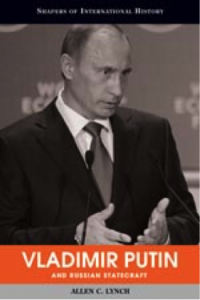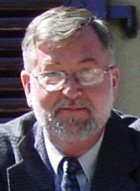 Review by Dr. John Handley, Vice-President of American Diplomacy Publishers
Review by Dr. John Handley, Vice-President of American Diplomacy Publishers
Vladimir Putin and Russian Statecraft, by Allen C. Lynch, Washington, D.C.: Potomac Books, 2011, ISBN 978-1-59797-298-7, 184 pp., $24.95.
Allen Lynch is a professor of politics at the University of Virginia and, from 1993 to 2008, served as the director of the university’s Center for Russian and East European Studies. He is a former assistant director for the W. Averell Harriman Institute for the Advanced Study of the Soviet Union at Cornell University and the author of several books, including How Russia is Not Ruled: Reflections on Russian Political Development, (2005) and Does Russia Have a Democratic Future? (1997).
The author readily admits that this book is not a biography of Vladimir Putin, but rather a look at how Putin managed to work his way to the top in Russian political circles and what he accomplished during two presidential terms. Dr. Lynch refers to his assessment, as “a tentative exercise” while the historical appraisal of Putin must wait until he no longer possesses political power, and that date may be a long way off. Dr. Lynch fully expected Putin’s election to a third and probably fourth term as president and the world now knows that Putin, after his two presidential terms and serving for four years as prime minister, very recently did win his third presidential election. The author hopes to explain why Americans and Russians have such contrasting views of Putin’s accomplishments as well as to offer an evaluation of his record in the Kremlin. For Dr. Lynch, Putin’s statecraft flows from the interaction of personality and circumstances.
To give the reader some idea of the depth of each of the chapters, this reviewer presents a fairly comprehensive analysis of the first chapter, “The Formative Years (1952-1990).” To do the same for the remaining chapters would deprive the reader of the joy of reading the book, thus subsequent chapters are addressed much more succinctly. In this first chapter, the author examines Putin’s family background as well as his family, school, university, the KGB, and the Soviet secret police socialization. His lack of anti-Semitism may well stem from the fond memories he has of his German teacher, a Jewish lady, for whom as president he purchased an apartment in downtown Tel Aviv. As a teenager, having read every spy novel he could find, he decided on a career in the secret services. An impulsive “bully,” the Soviet Pioneer organization rejected him as “uncontrollable.” To master his temper, Putin studied judo, karate, and the Russian martial art of sambo. Sports changed his life or the better. His grades improved and he decided to study law. He was accepted into Leningrad State University under the Russian version of affirmative action, and while there met his future St. Petersburg city hall mentor, the liberal economics professor, Anatoly Sobchak. Putin became a master of sambo in 1973, a master of judo in 1975, and later earned a black belt in karate. Putin’s public persona in college was that of a “hardworking, disciplined, athletically impressive but socially unobtrusive and apolitical man” (16).
Putin’s KGB career began in 1975 when, at 22, he joined the agency and was posted to Leningrad, first in the secretariat, then operations, then (domestic) counterespionage, and finally foreign counterespionage, departing Leningrad in 1984. He went to Moscow to train for his subsequent assignment to Dresden, East Germany, arriving there in 1985 as a major. Previously, in 1980, Putin met his future wife, Lyudmila. They married in 1983 with daughters Maria and Katya born in 1985 and 1986 respectively. By the end of 1989, having received three promotions, Putin experienced the fall of the Berlin Wall and the ensuing paralyses of the Soviet state in failing to come to his assistance as an angry mob descended on the KGB building where he was temporarily acting as the head of mission. He talked to the crowd and convinced them to disburse, but the encounter created one of those significant emotional experiences that would help form his idea of state power. He decided then and there that the power of the state had to be strengthened.
Chapter 2, entitled “In St. Petersburg’s City Hall (1990-1996),” analyzes Putin’s critical post-Soviet tenure as the deputy mayor of St. Petersburg having resigned from the KGB in 1990. As deputy mayor, Putin did not acquire personal riches. For the one charge of corruption brought against him, the alleged purchase of a million-dollar villa in France, Putin sued for slander and won. In 1996, while Putin worked for the re-election of his mentor, Sobchak, Putin became painfully aware of the underhanded but perfectly legal political tactics that saw Sobchak lose in a close race. Yeltsin advisors brought charges of corruption against Sobchak and Putin orchestrated a secret and clearly illegal operation to whisk Sobchak to France. Yeltsin, no Sobchak supporter, decided he needed someone with Putin’s loyalty and offered him the prime minister’s office.
Chapter 3, “To Moscow and the Top (1996-1999),” reviews Putin’s various underling roles to successive Kremlin officials, to deputy head of the Presidential Administration, to Chief of the FSB (successor to the KGB), to head of the National Security Council, and culminates with his appointment by Boris Yeltsin as prime minister in 1999. Putin’s handling of three potential problems for Yeltsin convinced the latter that Putin was a trustworthy successor. First, Putin purged the FSB of those disloyal to Yeltsin and his family. Second, Putin managed to publically disgrace the chief prosecutor who was preparing an indictment against Yeltsin’s daughter. Third, as head of the National Security Council, Putin managed to impose his will on the Chechen situation by a second, now successful, invasion of the Russian province and something akin to conducting total war on the rebels.
In the fourth chapter, “Putin at the Helm (1999-2000),” Dr. Lynch discusses Putin’s initial months as prime minister and then acting president with considerable attention paid to the Chechen War, a decisive factor in Putin’s rise to the Russian presidency. Chapters 5 and 6 address domestic and foreign policy respectively. In both Chapter 5, “Putin in Power: Domestic Politics and Policies,” and Chapter 6, “Putin in Power: Foreign Policy,” Dr. Lynch focuses on how Putin developed an authoritarian political machine while stabilizing the state and resolving the country’s economic and financial concerns. Part of this development comes from Putin’s experience with a hostile press over the sinking of the Kursk in 2000. Putin learned it was better to punish the messenger than to address the cause of the problem. The author examines the relationship Putin attempted to build with the U. S., France, and Germany and with Putin’s concern in asserting Russian predominance across the post-Soviet periphery. The author concludes with an assessment of Putin’s record in economic, political, and diplomatic spheres. In addressing Putin’s hold on power, Dr. Lynch states relatively early in the book: “The methods by which he built his power base, with their heavy reliance on state control of huge swaths of the economy and society, foreclosed the development of meaningful democratic or even legal government” (66). The author continues on the same page with the following assessment: “Whether it was in terms of state capitalism and a related tsunami of corruption, strict government control of televised political news, blatant political manipulation of the judicial system, harassment of political opponents, or studied indifference to the murder of a score of critical journalists, Putin in two terms as president had created a political machine that … seemed incapable of genuine evolution.” Throughout the book, Dr. Lynch discusses the tensions and paradoxes that impacted on both Putin’s life and his tenure in office.
This reviewer thoroughly enjoyed the book. It is well written, well sourced, and yet remarkable easy to read for anyone who is interested in Vladimir Putin and his rise to power. I recommend it to professionals and laymen alike for a better understanding of the man who has dominated Russian political power for the past twelve years and may well do so for the next eight.![]()
American Diplomacy is the Publication of Origin for this work. Permission to republish is freely granted with credit and a link back to American Diplomacy

